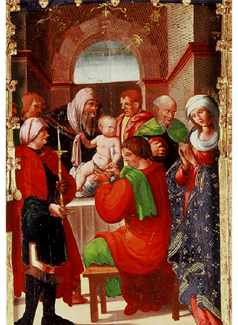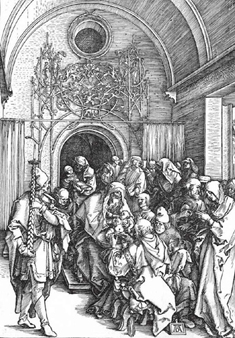BRINGING HERITAGE CLOSER. OLITE, ROYAL SEAT
30 August 2007
The painter Pedro de Aponte in Olite
Carmen Morte. University of Zaragoza
There is documentary evidence of the presence of the painter Pedro de Aponte in Olite, in 1528 and 1530, although it is possible that his relationship with this town was earlier. In 1525 it is proven that Aponte entered the Navarrese art market by contracting the main altarpiece of the parish church of Cintruénigo. The link of this painter with Navarre was not only because of his works or his death in Olite (1530), but also because his most direct descendants settled in this ancient kingdom. The daughters of his first wife lived in Burgui, Pedro Jerónimo de Aponte, son of the painter and his second wife, María Arruego, would live in Olite and the latter would remarry Pedro de Rada, an infanzón, the Maestresala of the Marshal of the Kingdom of Navarre.
One of the most singular works of Pedro de Aponte and his workshop is the monumental main altarpiece of the parish church of Santa María de Olite (9.50 x m), whose painting panels are assembled in a Gothic masonry, except for the frieze of the sotabanco, which is Renaissance. The work is a good testimony of the splendor of this Navarrese town in the 16th century and is one of the most important pictorial projects carried out in Navarre in the first decades of the 16th century. The paintings of the altarpiece denote a link to the painting styles of the Hispano-Flemish tradition, but innovated by the influence of the prints of the Germanic master Albrecht Dürer and nuanced by the Italian Renaissance forms. The work is related to the documented major altarpieces of Pedro de Aponte: Grañén (Huesca, 1511-1513), Ágreda (Soria, 1523-1525) and what corresponds to that of Cintruénigo (Navarra, 1525-1530).

Parish Church of Santa Maria de Olite. High Altarpiece. "Circumcision". Pedro de Aponte
In the Olite altarpiece, a broad doctrinal programme is developed in the numerous small panels, from agreement to the narrative sense of late Gothic with the multiplication of episodes in the altarpieces. We can say that the final goal of his painting is to narrate sacred stories with the greatest dramatic tension in the scenes of the Passion. The bright colouring and the abundance of gold add to the overall attractiveness of the painting. The architectural framework painted on the panels of the Olite altarpiece reveals the duality of two systems: Gothic and Renaissance, as the columns with Corinthian capitals support ribbed vaults and pointed arches, joined by other semicircular arches, as in the Pentecost panel.
In his spatial representation, Aponte attempts to achieve a convincing space, although this representation lacks the mathematical rigour of Italian Renaissance perspective and has an empirical approach , in the same way as his medieval predecessors had done, in what has been called natural or optical perspective, according to a purely mechanical function of the eye by means of geometric-spatial recipes inherited from a long tradition of workshop practices, i.e. there is no mathematically regular diminution of everything represented according to a fixed vanishing point, according to the system of perspective developed by Brunelleschi in his two famous tables and systematised by Alberti (Della Pittura, 1435).

Albrecht Dürer. "Circumcision
The latest restoration of the altarpiece, financed by the Government of Navarre, has made it possible to study the underlying drawing of the paintings. This is schematic, simple in its composition and with few nuances, limited to a long stroke to mark the basic lines and lines for the shading and modelling, although this is done more with colour. There is also a generalised use of incised drawing in the panels of the Olite altarpiece, where azurite and gold were used.
PROGRAM
MONDAY, 27TH AUGUST
Place: Olite. Cultural Centre
16.30 h: Opening and presentation of the course
16.45 h. The urban development process of a town in the area average Navarra: Olite
Prof. Carmen Jusué. University of Navarra
17.45 h. Coffee break
18.15 h. The parish of San Pedro
Prof. Asunción Domeño. Chair of Navarrese Heritage and Art
19.15 h. Guided tour of the town centre of Olite
Prof. Javier Corcín. high school Prince of Viana. Olite
TUESDAY, 28TH AUGUST
Place: Olite. Cultural Centre
16.30 h. The mural paintings of Olite during the Gothic period
Prof. Carmen Lacarra. University of Zaragoza
17.30 h. Coffee break
18.00 h. Santa María la Real de Olite: a living heritage
Prof. Mercedes Jover. Chair of Heritage and Navarrese Art
19.00 h. The Palace of Olite, project and the construction of a royal setting
Prof. Javier Martínez de Aguirre. Chair of Navarrese Heritage and Art
WEDNESDAY, 29TH AUGUST
Place: Olite. Convent of San Francisco
16.30 h. Devotion and the plastic arts in the 17th and 18th centuries
Prof. Ricardo Fernández Gracia. Chair of Navarrese Heritage and Art
17.30 h. Coffee break
18.00 h. Religiosity and artistic promotion in Olite: its convent complexes
Prof. Javier Azanza. Chair of Heritage and Navarrese Art
19.00 h. visit Guided tour of the rooms of the Convent of San Francisco
THURSDAY, 30 AUGUST
Place: Olite. Cultural Centre
16.30 h. The painter Pedro de Aponte in Olite
Prof. Carmen Morte. University of Zaragoza
17.30 h. Coffee break
18.00 h. Closure: Evocation and reality: the image of Olite in the 19th and 20th centuries.
Prof. Ignacio J. Urricelqui. Chair of Navarrese Heritage and Art
19.00 h. visit to the Pagos de Araizwineries

